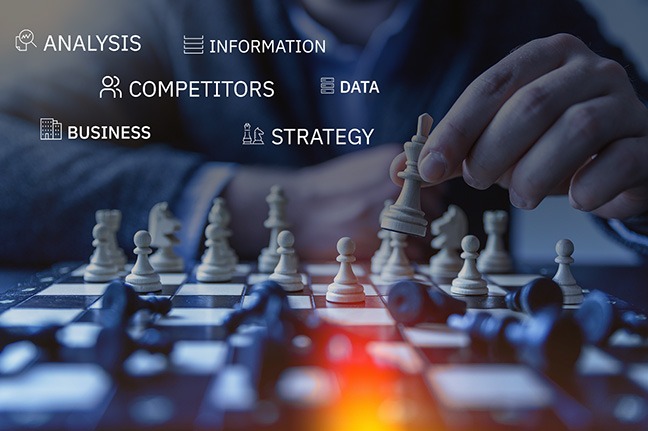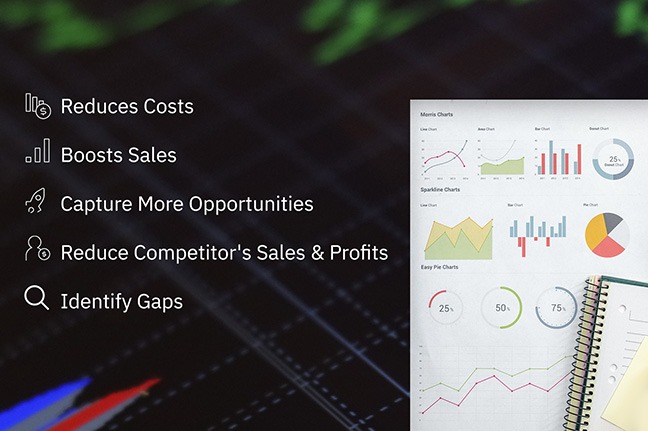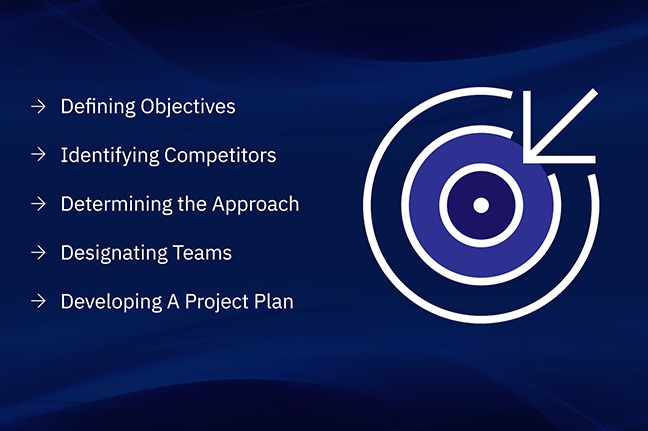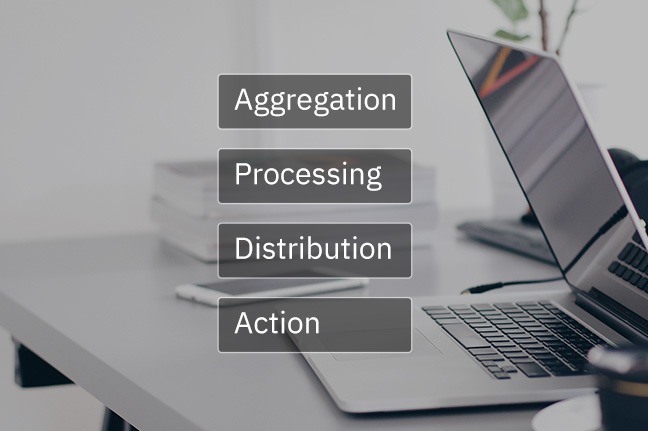In 1983, Motorola CEO Bob Galvin built one of the first formal corporate Competitive Intelligence groups, which served as an integral part of senior decision-making within the organization for the next 26 years. Since then Competitive Intelligence (CI) has slowly made its way into the list of necessary business practices. However, it is often confused with competitors' analysis and/or corporate espionage. It is neither. It is also not corporate networking, nor is it a simple Google search about your competitors.
Now that we know what it isn't, let's begin the pursuit of knowing what it is. This definitive guide will tell you everything there is to know about Competitive Intelligence, with goals, examples, and more. It’ll also talk about how you can use CI to identify and seize opportunities for the success of your company. Let's dive straight in!What Is Competitive Intelligence?

Competitive Intelligence can be defined as the systematic collection and analysis of information from multiple sources about products, customers, competitors, and other market factors needed in strategic business decisions. According to Harvard Business Review, CI shouldn’t be just about your competitors, and it isn’t. It’s any actionable information that contributes to your business’s competitive advantage. Its salient features are as follows:
1. CI involves ethical and legitimate research and information-gathering, as opposed to corporate espionage, which is illegal.
2. Sources to gather CI include, but are not limited to company websites, company press releases, social media postings, online job postings, review websites, company information aggregators as well as user groups on social networks.
3. Raw data gathered has to be curated, processed, and made useful and relevant by filtering out any noise, before it can be called CI.
The Importance of Competitive Intelligence

Competitive intelligence is important for companies as a part of their business strategy as it helps them understand their competitive environment, its opportunities as well as its challenges. It acts as a bridge between information and action. Modern markets are highly dynamic, and any company that desires to be on the top of its target industry must track its competitors. It’s imperative that they have a comprehensive and holistic view of the industry and competitive landscape. The importance of CI thus can be delineated through the following points:
1. Reveals qualitative and quantitative information on business activities (of both the competitor and self) based on relevant online and public sources.
2. Lends predictive insights into emerging industry trends, expectations, technologies, disruptors, and more.
3. Improves decision-making as every strategy is backed by actionable insights and research.
4. Enhances time-to-market, market-entry, and market defense capabilities.
5. Aids in predicting a competitor’s behaviors across business domains.
Competitive intelligence is made up of insights and information aggregated for competitive advantage, which when utilized suitably, provide businesses with the most detailed and accurate course of action.
Competitive Intelligence Examples

Competitive intelligence is now being increasingly used by companies as it brings extensive market research into your competitive landscape. Being able to analyze your competitors’ practices, pricing, products, etc. spurs smarter, more informed business decisions of your own. Bad CI, or worse, its complete lack can lead to a lack of clarity when making decisions, problems when measuring ROI, and maybe even loss of market share. Contify is an artificial-intelligence-enabled, competitive and market intelligence platform that has been used by global organizations across industries for secondary monitoring, and to gain actionable insights on their market and competition. The following are a few examples of how this platform has helped global companies gain actionable competitor intelligence and improve their market position. Let’s have a look.
Leading Competitive Intelligence Research Company Transforms the Strategic Decision-Making Process for its Pharma Clients
- 1. Business Challenges
- The research company conducted manual tracking of the client’s competitors’ company websites, news sources, and regulatory databases. This process was inefficient, labor-intensive, and time-consuming.
- 2. Solution
- Contify deployed a customized AI-enabled competitive and market intelligence solution that can deliver real-time updates. This entailed a tailored taxonomy, deploying a customized platform, monitoring regulatory sources, tracking live coverage of pharmaceutical events to gather insights, and creating a dedicated newsfeed with analysis.
- 3. Impact
- Contify’s solution resulted in 30% time-saved in manual research, 2X faster decision-making, and 20% accelerated business growth for the research company.
- Read case study
- California-Based Bank Leverages Market and Competitive Intelligence for Strategic Decision-Making
- California-Based Bank Leverages Market and Competitive Intelligence for Strategic Decision-Making
- 1. Business Challenges
- No formalized setup to aggregate, structure, and deliver strategic insights. Intelligence was sourced in an ad-hoc manner from secondary research, professional networks, private meetings scattered across teams.
- 2. Solution
- Contify adopted a three-stage process to define what insights can be classified as ‘actionable’ by each of the functions within the bank. The final solution included a M&CI platform, daily instant alerts, intelligence reports, and tracking on key market trends and product insights.
- 3. Impact
- Contify’s solution resulted in a 35% reduction of time spent on manual research, and 20% more leads available to sales representatives.
Management Consulting Firm Automate Competitive and Market Intelligence While Tracking Company Websites and Non-English Sources
- 1. Business Challenges
- Analysts were having a hard time tracking markets and competitors across geographies, services, and industries.
- 2. Solution
- A customized market and competitive intelligence platform for automating and simplifying analyst workflows through exhaustive competitor tracking. The platform allowed the firm to track intelligence across multiple foreign languages, keep tabs on the competition, integrate custom consulting-specific sources, tailor contextual noise-filtering algorithms to work for different analysts and build a taxonomy customized to match the firm’s internal business structure.
- 3. Impact
- Contify’s solution optimized 10 hours per week of analyst time, enabled 2x faster executive decision-making and empowered 50+ research analysts.
Advantages of Competitive Intelligence

Investing in CI gives companies several advantages. It empowers business strategies as well as competitive activities. It also prepares the organization for shifts in the market. When you are tracking both the market itself and the other players present in it, there’s little that can surprise you. Let’s have a look at the list of advantages competitive intelligence brings with it.
1. Reduces Costs: Not investing in CI costs companies more in the long run. Implementing it saves both time and labor, and brings in invaluable benefits in actual spend, cost savings and knowledge.
2. Boosts Sales: Competitive intelligence helps you structure sales processes and attain an efficient methodology to drive sales numbers.
3. Capture More Opportunities: Competitive intelligence offers you a comprehensive view of the market and your competition. When you have abundant usable information, you capture more opportunities like partnerships, improving market positioning, increasing market share, identifying untapped areas of the market, etc.
4. Reduce Competitor’s Sales and Profits: The world of business is fiercely competitive. Your profit is your competitor’s loss and vice-versa. Competitive intelligence allows clamping down on your competitor’s market share, sales and profits, as you’re always one step (or several steps) ahead of them.
5. Identify Gaps: Knowing your own strengths and weaknesses is equally important as knowing your competitor’s. Competitive intelligence constantly allows you to make strategies and plan new products or services that set you apart and fulfill a market requirement. It also allows for regular internal assessments from the market’s point-of-view.
What Are The Goals of Competitive Intelligence?

The end goal of competitive intelligence is to improve and differentiate your business from the competition. This is done by getting a comprehensive view of the market and competition which allows you to make strategic decisions with a higher level of confidence. This is a process that in itself is made up of smaller milestones that will factor into the end goal. Let’s have a look at those goals/smaller milestones.
1. Defining Objectives– Before you can begin working towards your goal, you first need to define it. CI will help you gain strategic and marketing insights on what your actual business requirements are, which will help you define the outcome you want. Usually, the goal or objective is something like this: Analyze and understand the go-to-market strategies for the top 5 competitors.
2. Identifying Competitors – You think you know your competitors, but a CI analysis may throw up results that may surprise you. Certain “emerging” competitors may turn out to be actual threats to your business, and certain long-time competitors may be further down the ladder than you expected. Identifying actual competitors, at least five of them, is the second goal.
Download competitive analysis template
3. Determining the Approach – Now that you know your objectives, and your competitors, the goal is how to approach the completion of your goal. Use CI for data collection, both quantitative and qualitative, and create a list of specific deliverables that will be required for the accomplishment of your goal.
4. Designating Teams – The completion of your goal will require designating specific teams for specific tasks. Thoroughly analyzing the insights from competitive intelligence will help you pick your teams which may consist of a mixed bag of both internal and external resources from various departments. Use it to look for information on such a thing done previously or being done by your competitors.
5. Developing A Project Plan – With everything in its place, the final goal is the development of a project plan which will allow you to accomplish your end goal. Meet with your teams and your stakeholders, base your plan on actionable intelligence, and kick-off your plan. CI will even help suggest actions during the execution of the said plan, however, functional leaders must take ownership of the execution.
Frequently Asked Questions (FAQ)
What Types of Competitive Intelligence Reports are Available for Companies?
There are several types of reports that are made available to agencies by competitive and market intelligence industry experts like Contify. A company can itself compile such reports using an M&CI platform as well. Let’s have a look at these types.
Company Data Report
Such a report is compiled to gauge a company’s (both yours and your competitors’) dimensions. It consists of a variety of data like:
1. Revenues, expenses, and profits.
2. Employees
3. Company history and background
4. Recent mergers & acquisitions
5. Location, facilities, and delivery centers
Financial Data Report
Such a report is compiled to gauge a company’s (both yours and your competitors’) financial strength, and comprises a variety of data like:
1. Performance metrics – Revenues, profits, operating expenses.
2. Business segments – Performance of each business segment.
3. Return – Return on capital employed and equity.
4. Assets – Total value of tangible and intangible assets.
5. Capital – Total shareholder capital and promoter stake.
Product Comparison Report
A product comparison report is based on the merits and demerits of your product and that of your competitor, as well as how you compare against each other. It consists of the following information:
1. Existing Features – Features present in your competitor’s product and how your product compares against it.
2. Upcoming Features – Features that your competitors are building.
3. Pricing – The price of their products (including discounts, individual pricing plans) versus yours.
4. Market Share – Product market share in geographies and customer segments (theirs vs yours).
5. Marketing – The marketing efforts of your competitors.
6. Customers – Number of customers for each product that you compete against and their wallet shares.
7. Game Plan – May or may not be a part of this report, lists down ways how you will compete with them.
Strategic Comparison Report
Such a report compares your strategies and business performance with your competition. It consists of the following information:
1. Strengths – Core features, assets, management and USP of both you and your competitor.
2. Weaknesses – Your shortcomings vs theirs, plus the competitor’s strengths.
3. Opportunities – New customer segments, uncharted business segments, new geographies, etc.
4. Threats – Emerging competition, new technologies, negative reviews, etc.
Quantitative Scorecard
This is a numeric scorecard which measures how good your company is versus your competitors across parameters like:
1. Core product features/competencies
2. Non-replicable assets like trademarks and patents
3. USP of products/solutions/services
4. Location
5. Customer support
6. Customer reviews
7. Company reputation
8. Ease of use
9. Partner & Reseller network
10. Marketing strategy
How Do You Get Competitive Intelligence?
Traditionally, companies use a number of sources like marketplace surveys, interviews with experts, focus groups, journalists, blogs, wikis, conferences, customers, etc. Obtaining intel from these sources requires advanced competitive intelligence tactics and can be time-consuming and effort-intensive if done manually. Now, you can use tools like Contify, which gather curated and accurate information by searching and analyzing over 500,000 online sources including news, company websites, social media, reviews, discussion forums, job postings, regulatory portals, and more. This will save your business a lot of time and effort.
Download M&CI Process Template
What is The Competitive Intelligence Process?

The process consists of four parts, namely:
1. Aggregation: Information is aggregated from several thousand sources such as news, company websites, regulators, social media, press releases, and job portals. Custom sources such as discussion forums and your favorite trade publications can be added.
2. Processing: Actionable intelligence is extracted from unstructured digital noise.
3. Distribution: Intelligence is tailored to your internal business taxonomy, and the personalized intelligence is delivered to your teams and other stakeholders.
4. Action: Using intelligence, a roadmap is created and then executed to close performance gaps and remedy pain points, realigning operations and budgets toward strategic growth priorities.
Is Competitive Intelligence Expensive?

Not necessarily. While competitive intelligence isn’t exactly inexpensive either, each company has to find its own balance, adjusting it to available resources. There’s also platforms like Contify which offer plug-and-play pricing to make it more economical for you. Whether you consider competitive intelligence expensive or not depends on its importance to your business. Processes like quality management or human resources management often have higher expenses than CI, but they aren’t considered expensive as they are essential. Similarly, whatever be the cost to be put in initially depending on your needs, CI is something that should be undertaken by every company. Basing your company’s direction on strategies that lack accurate intelligence can be downright harmful to your business, which will actually be very expensive.
Is Competitive Intelligence Ethical?

As mentioned before, Competitive intelligence involves legitimate research and information-gathering from public sources of information. It is completely legal based on written law. Ethics, however, are based on a person’s understanding of right and wrong, so opinions may differ. Having said that, there is extensive intelligence data available online that you can gather about your competitors legally, and there are no unethical means involved.
Conclusion
Businesses now operate in a world in which information is more readily and publicly available than ever before. Every organization in the world has the right to compile data and use it to its competitive advantage. Competitive intelligence is on its way to become a mainstream business process , as it should. However, it is up to every individual organization to make this choice for themselves. CI is not just about outmaneuvering your competitor, but elevating your company and business to the point where they can no longer compete with you. Here’s hoping that this article helped you comprehensively understand competitive intelligence, and you’ll use this understanding to make informed decisions.



